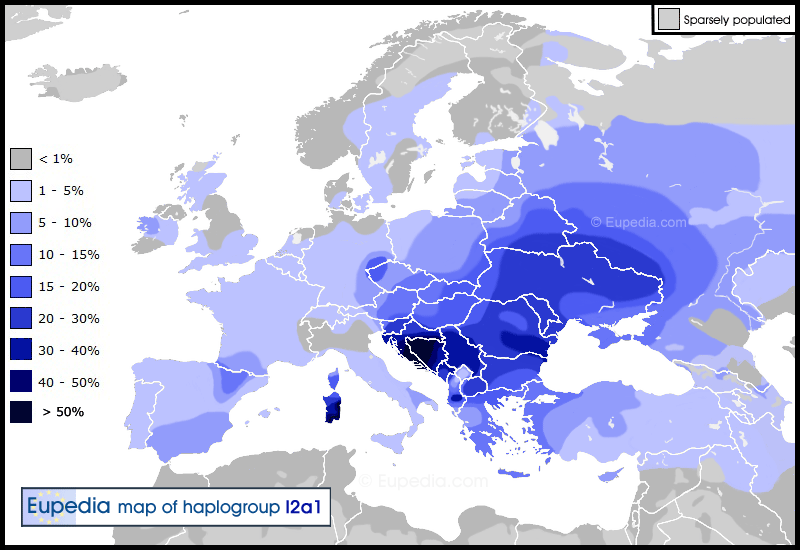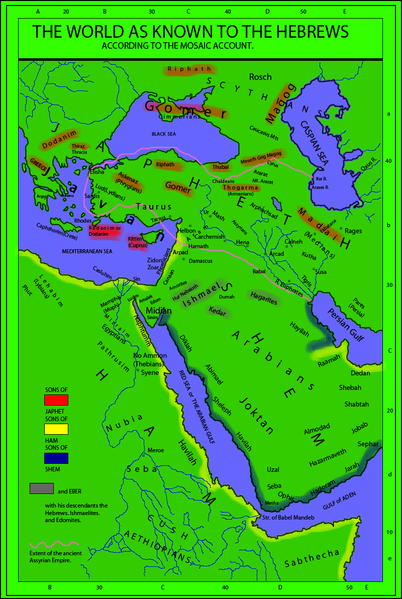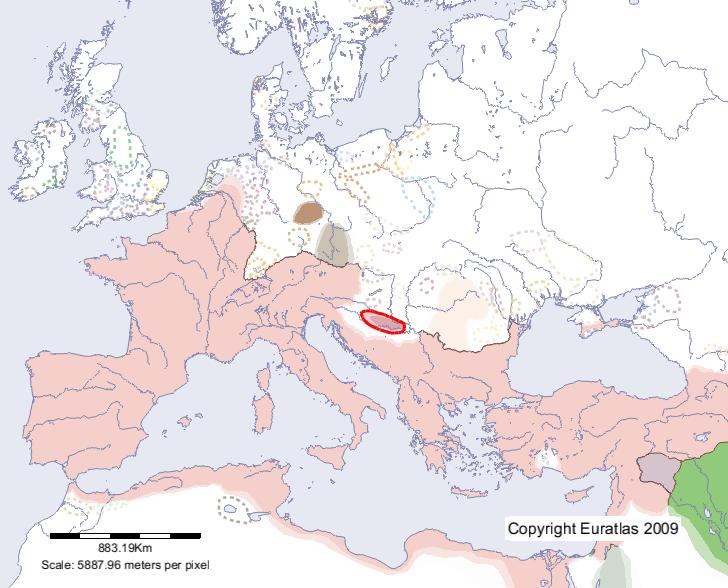we know that early Slavs are identified by Jordanes as populous race of Veneti... and we can also see that known spread of early Slavs does match pretty well directions of spread of I2a2 (disregarding the Balkan spread)
another indicator that early Slavs were dominantly I2a2 people is that R1a is roughly the same percentage in Slavic FYRM Macedonians, non-Slavic FYRM Albanians and Slavic Serbia, while it is significanly less in Slavic Montenegro... while I2a2 is dominant in all south Slavs... also besides being in low frequencies, R1a in Bosnia, Serbia and Macedonia is according to Klyosov ancient old, much older than in all other areas of the world together.. so most or much of it could not have come there with early Slavs, but was there long long time ago... it is also more frequent in Greek Macedonia than in all surrounding Slavic lands, and hotspot of R1a in south Balkan matches perfectly shape of ancient Macedonian state... in my opinion, all this indicates that Slavs who entered Balkans were thus almost exclusively I2a2... as they came from different areas, it is possible that all early Slavs were originally dominantly I2a2..
http://www.eupedia.com/forum/showpost.php?p=364602&postcount=323
http://www.eupedia.com/forum/showpost.php?p=364837&postcount=78
btw. Scordisci might have been I1 as their spread was along Sava-Morava valleys from Slovenia to Sar mountain (named after them and located in northwest Albania/northeast Macedonia, south most part of Kosovo/Serbia), which is pretty good match for I1 Balkan hotspot on this map...
I1 is higher in ethnic Albanians than in Macedonians, and higher in Serbia than in Bosnia and Montenegro, which all indicates pre-Slavic population...but this could have been due to Goths as well though, while Scordisci than could have been I2a2 afterall... thing is there is for sure also pre-Slavic I2a2 in Balkans as in Greece it is high in some areas that were not settled by Slavs....and because Slavs never settled Adriatic coast in Italy while Illyrians did and there is some I2a2 along the italian Adriatic coast according to map of Maciamo...
anyway, Serians of Europe are perhaps someone else ...
Scirii maybe...let me explain..
Scirii might have been a way to write down tribal name Sirri (which is alike to Serians) the same way as Slavs (Slaveni) were written down as Sclaveni...
Scirii are paired with Hirri (I will explain later that I relate these names to Serians and Hurrians) same as serbs with Croats are often paired...
Scirii appears in history in times when Siraces (thought to be the same as Serboi) disappear....
first mention of Scirri - 3rd century, area northwest of Black sea..
The Protogenes Inscription (3rd century BC) mention the Sciri together with the Galatians and probably Indo Iranian Saii[1] when they tried unsuccessfully to capture the Greek city Olbia, northwest of the Black Sea. It has been suggested that the Sciri, like the Hirri, as mentioned by Pliny the Elder in association with Sarmatians and Venedi, actually belonged to the latter since he does not mention the Sciri among the German people and neither Caesar nor Tacitus mention the Sciri at all.[2] They reappear only at the time of Attila the Hun.
http://en.wikipedia.org/wiki/Scirii
Scirii and Hirri are thus among Venedi/Veneti and according to Jordanes early Slavs are Veneti... thus, very good match for proto-Serbs and proto-Croats!!!
last mention of Siraces - area northeast of Black sea
In 193 AD, after another conflict in the Bosporus, the Siraces disappears from the history.[2]
They are believed to be the same or connected to the Serboi.
http://en.wikipedia.org/wiki/Siraces
I2a2 and R1a are present in various regions of Asia minor...
I2a2 in west of Asia minor are Lydians... (hm, perhaps origin of Lędzianie tribe of Poles...)
now look at this peculiarity
The sacred bull of the Hattians, whose elaborate standards were found at Alaca Höyük alongside those of the sacred stag, survived in the Hurrian and Hittite mythologies as Seri and Hurri (Day and Night)—the bulls who carried the weather god Teshub on their backs or in his chariot, and grazed on the ruins of cities.[2]
http://en.wikipedia.org/wiki/Bull_(mythology)
I think it makes lot of sense to relate Scirii and Hirri with Seri and Hurri, with Serians and Hurrians, and proto-Serbs and proto-Croats... you can read more on link bellow ...btw. before reading also note that Scirri and Hirri are among Venets/Venedes... and in Asia Minor Seri and Hurri carry weather god.. read why this is also about Seri and Hurri being part of/related to Paphlagonia Eneti (ancestors of Veneti according to Herodotous) and living south of them in mountain Taurus (bull) area...
http://www.eupedia.com/forum/showpost.php?p=365077&postcount=440
regarding the mention of Scirii and Hirri as east Germanic tribes, well it may be indeed the case as I2a2 in Asia minor matches spread of Cimmerians also known as Gomer people (named after their eponymous ancestor Gomer from whom Germanic people origin)...
note that Veneti are also thought by some to be Germanic people... they are as I indicated many times probably also I2a2 dominant people... and early Slavs are Veneti according to Jordanes... in fact, split between I1, I2b1, I2a2-Isles and I2a2-Dinaric might correlate to split between Slavic and Germanic languages...
on other hand, satem variant of indo-european does correlate with spread of R1a as it is spread in Slavic land, among Iranian and Indian people... so, what is now known as Slavic language could have been language of R1a... note that it is also possible that Serians and/or Hurrians were originally R1a as Taurus area has R1a and had more of it before Etruscans departed for Italy....this would explain Sorbs being R1a dominant and original Croat surnames having more often R1a than I2a2 in Croats (according to Japodos)....but note that I2a2 island in Asia minor that matches Gomers settlement in past, is now in Kurds, which is tribal name that might have same origin as Serbs....
in general haplogroup I seems to have 2 patterns for tribal names spread accross diferent branches
Swedes, Suebi, Serbs, Sarbans, Sardinians...
Kerman, Germans, Gomer/Gimrri (Cimmerians), Garamantes...
see
http://www.eupedia.com/forum/showpost.php?p=365078&postcount=86
http://www.eupedia.com/forum/showpost.php?p=365136&postcount=88
btw. Hurrians are related to Subartes...
I. J. Gelb & E. A. Speiser believed Subarians had been the linguistic and ethnic substratum of northern Mesopotamia since earliest times, while Hurrians were merely late arrivals.[citation needed
http://en.wikipedia.org/wiki/Hurrians
The land of Subartu (Akkadian Šubartum/Subartum/ina Šú-ba-ri, Assyrian mât Šubarri) or Subar (Sumerian Su-bir4/Subar/Šubur) is mentioned in Bronze Age literature. The name also appears as Subari in the Amarna letters, and, in the form Šbr, in Ugarit.
Subartu was apparently a polity in Northern Mesopotamia, at the upper Tigris, in the general sphere of influence of the Hurrians. Its precise location has not been identified. From the point of view of the Akkadian Empire, Subartu marked the northern geographical horizon, just as Martu, Elam and Sumer marked "west", "east" and "south", respectively.
http://en.wikipedia.org/wiki/Subarians
Shupria (or Arme-Shupria) was a Hurrian kingdom, known from Assyrian sources beginning in the 12th century BC, located in the Armenian Highland, to the southwest of Lake Van, bordering on Urartu proper.
Together with Armani-Subartu, Hayasa-Azzi and other populations of the region, they fell under Urartian rule in the 9th century BC, and their descendants later contributed to the ethnogenesis of the early Armenians.[1]
http://en.wikipedia.org/wiki/Shubria note Shubria in link...
I remember reading on some forum that Armenians also have I2a2 (but think only samples of Armenians were from ones living in Russia)... but that needs to be checked..












